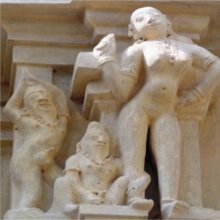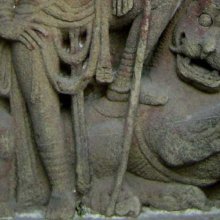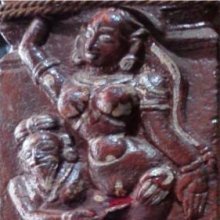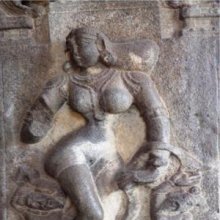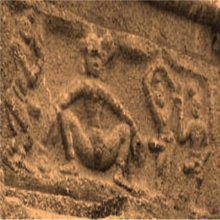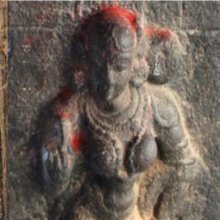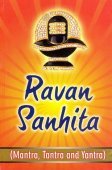Bhairavi, Bhairavī: 17 definitions
Introduction:
Bhairavi means something in Buddhism, Pali, Hinduism, Sanskrit, Marathi, Jainism, Prakrit, Hindi. If you want to know the exact meaning, history, etymology or English translation of this term then check out the descriptions on this page. Add your comment or reference to a book if you want to contribute to this summary article.
Images (photo gallery)
(+11 more images available)
In Hinduism
Shaktism (Shakta philosophy)
Source: Wisdom Library: ŚāktismBhairavī (भैरवी, “the fearful Goddess”):—The sixth of the ten Mahāvidyās. She represents the power of death. She embodies the force of destruction wherever there is creation. Her power resonates when pertaining to activities such as drinking alcohol or using drugs and she is strengthened by emotions like anger, jealousy or hatred. The ten Mahāvidyās are the emanations of Mahākālī, the Goddess of time and death. She is depicted as a fearful laughing goddess with four arms entwined with poisonous snakes in her hair. She has three red eyes, a wagging tongue and feaful teeth. Her left foot is standing on a corpse
Source: Google Books: Manthanabhairavatantram1) Bhairavī (भैरवी) is an epithet for the Goddess according to the Bhairavīstotra in the Śrīmatottara-tantra, an expansion of the Kubjikāmatatantra: the earliest popular and most authoritative Tantra of the Kubjikā cult.—Accordingly, “Victory! Victory (to you) O goddess (bhagavatī)! [...] (You are) Bhairavī whose being is (infinitely) great. (You are) the All and, (universally) pervasive, (are also) Revatī. O (you) who can bestow the means to both grace (anugraha) and curse (nigraha)! [...]”.
2) Bhairavī (भैरवी) refers to the Gesture associated with Tisra, one of the eight Sacred Seats (pīṭha), according to the Yogakhaṇḍa (chapter 14) of the Manthānabhairavatantra, a vast sprawling work that belongs to a corpus of Tantric texts concerned with the worship of the goddess Kubjikā.
Source: Google Books: The Yoginihrdaya, a Sanskrit Tantric TreatiseBhairavī (भैरवी) (or Mūlavidyā) refers to one of the Nine Vidyās (presiding over the nine parts of the Śrīcakra), according to the Yoginīhṛdaya (one of the principal works of Tantric Hinduism).—Accordingly, “The first is the Karaśuddhikarī, the second one Ātmarakṣikā, the third Ātmāsanagatā; then, after her, [comes] Cakrāsanagatā, then Sarvamantrāsanasthitā. Sādhyasiddhāsana is the sixth one, her nature being that of Māyā and Lakṣmī, supreme. The one called Mūrtividyā is the seventh goddess. The eighth one is the vidyā Āvāhinī; the ninth is the supreme Bhairavī, also called Mūlavidyā, subjugating the three worlds”.

Shakta (शाक्त, śākta) or Shaktism (śāktism) represents a tradition of Hinduism where the Goddess (Devi) is revered and worshipped. Shakta literature includes a range of scriptures, including various Agamas and Tantras, although its roots may be traced back to the Vedas.
Purana and Itihasa (epic history)
Source: archive.org: Puranic EncyclopediaBhairavī (भैरवी).—One of the eight Ambas. They are: Rudrārcikā, Rudracaṇḍī, Naṭeśvarī, Mahālakṣmī, Siddhacāmuṇḍikā, Siddhayogeśvarī, Bhairavī and Rūpavidyā. All these are the eight different forms of Devī. (See the word DEVĪ).
Source: Cologne Digital Sanskrit Dictionaries: The Purana IndexBhairavī (भैरवी).—An epithet of Umā; when Śiva is Bhairava, Umā is Bhairavī;1 a mother-goddess.2

The Purana (पुराण, purāṇas) refers to Sanskrit literature preserving ancient India’s vast cultural history, including historical legends, religious ceremonies, various arts and sciences. The eighteen mahapuranas total over 400,000 shlokas (metrical couplets) and date to at least several centuries BCE.
Vyakarana (Sanskrit grammar)
Source: Wikisource: A dictionary of Sanskrit grammarBhairavī (भैरवी).—Name given to a commentary in general written by Bhairavamiśra, which see above. The commentary on the Paribhāṣenduśekhara is more popularly known as Bhairavī.

Vyakarana (व्याकरण, vyākaraṇa) refers to Sanskrit grammar and represents one of the six additional sciences (vedanga) to be studied along with the Vedas. Vyakarana concerns itself with the rules of Sanskrit grammar and linguistic analysis in order to establish the correct context of words and sentences.
Shaivism (Shaiva philosophy)
Source: Brill: Śaivism and the Tantric TraditionsBhairavī (भैरवी) (also known as Paramā, Yogeśī or Aghorī) refers to the “consort of Bhairava”, according to the Brahmayāmala-tantra (or Picumata), an early 7th century Śaiva text consisting of twelve-thousand verses.—While the sādhaka seeks apotheosis as Bhairava, the divine body he takes on, the avadhūtatanu, in fact consists of a feminine power which ultimately transcends the male deity. The “unblemished” or “pure” (avadhūtā) Śakti is present not only as the cord which unites the lotus garlands: in mantric terms, she also pervades the garlands as hāṃ, the final syllable of the Nine-Syllable Vidyā (with the addition of anusvāra). In this form she is known as Paramā or Yogeśī , the eighth and highest Mother-goddess from whom the others emerge, and as Aghorī or Bhairavī, consort of Bhairava. Her simultaneous pervasion of the body and syllabic presence in each lotus are intimated in Brahmayāmala verse 4.595-596b.
Source: SOAS University of London: Protective Rites in the Netra TantraBhairavī (भैरवी) is name of the Goddess accompanying Bhairava according to the Netratantra of Kṣemarāja: a Śaiva text from the 9th century in which Śiva (Bhairava) teaches Pārvatī topics such as metaphysics, cosmology, and soteriology.—Accordingly, [verse 10.7cd-17ab, while describing the worship of Bhairavī and Bhairava]—“[Bhairavī] has the appearance of vermillion or lac. [She has] erect hair, a large body and is dreadful and very terrifying. [She has the medicinal plant] śatavārī, is five-faced, and adorned with three eyes. [Her hands bear] curved talons curved [She has] eyes like the hollow of a tree and wears a garland of severed heads. [Ten-]armed, like Bhairava [she also] bears Bhairava’s weapons [of an axe and hatched]. [...]”.

Shaiva (शैव, śaiva) or Shaivism (śaivism) represents a tradition of Hinduism worshiping Shiva as the supreme being. Closely related to Shaktism, Shaiva literature includes a range of scriptures, including Tantras, while the root of this tradition may be traced back to the ancient Vedas.
General definition (in Hinduism)
Source: WikiPedia: Hinduism1) Bhairavi is a fierce and terrifying aspect of the Devi virtually indistinguishable from Kali, except for her particular identification as the consort of the Bhairava. She is also called Shubhamkari, Bāla or Tripurabhairavi.
It is believed that when Bhairavi entered the battle field, her horrible appearance made the demons become weak and very feeble, and it is also believed that most of the demons started panicking as soon as they saw her. The consort of Goddess Bhairavi is Bhairava an aspect of Shiva.
2) Bhairavi is also a title for a female adept in Kundalini Tantra. A Yogini is a student of Tantra, or an aspirent. A Bhairavi is one who has succeeded. Supposedly there are many more levels of achievement than these two, but Tantra is, in essence, a mystery religion, and one would have to be initiated, to learn them all. The name "Bhairavi" means "Terror," or "awe-inspiring," so the one who has achieved the state of Bhairavi, is beyond the fear of death, and therefore awesome.
Source: Vedanta Society: The MahavidyasThe name Bhairavi means “frightful,” “terrible,” “horrible,” or “formidable.” The basic idea here is fear. Ordinarily we associate fear with darkness. It is not uncommon to be afraid of the dark, or rather of the dangers that lurk there unseen, but that is not the sort of fear that Bhairavi provokes, for she is said to shine with the effulgence of ten thousand rising suns.
In her individualized aspect, Bhairavi is the power of consciousness dwelling in every human being. Then she is known as Kundalini. Basic to both the cosmic and individual aspects is identification of Bhairavi with tremendous power. It is often said that Bhairavi represents divine wrath, but it is only an impulse of her fierce, maternal protectiveness, aimed at the destruction of ignorance and everything negative that keeps us in bondage.
Sometimes she is in the cremation ground, seated on a headless corpse. Like Kali, she has four arms. With two of her hands she holds the sword of knowledge and the demon’s head that represents the destruction of the ego. Her other two hands may display the abhayamudra, urging us to have no fear, and the varadamudra, the gesture of granting boons. More often they hold a mala, signifying devotion, and a book, signifying knowledge. The trident represents the pervasively threefold nature of her manifestation and can be interpreted in a variety of ways.
In Buddhism
Tibetan Buddhism (Vajrayana or tantric Buddhism)
Source: academia.edu: The Structure and Meanings of the Heruka MaṇḍalaBhairavī (भैरवी) refers to one of the twenty-four Ḍākinīs positioned at the padma (lotus) in the middle of the Herukamaṇḍala, according to the 10th century Ḍākārṇava chapter 15. Accordingly, between the south and east (of the heruka-maṇḍala) are six Ḍākinīs who are half yellow and half black in color. They [viz., Bhairavī] are headed by the major four Ḍākinīs of the Cakrasaṃvara tradition. They stand in the Pratyālīḍha posture and, except for the body posture, their physical features and objects that they hold are the same as Vajravārāhīs.

Tibetan Buddhism includes schools such as Nyingma, Kadampa, Kagyu and Gelug. Their primary canon of literature is divided in two broad categories: The Kangyur, which consists of Buddha’s words, and the Tengyur, which includes commentaries from various sources. Esotericism and tantra techniques (vajrayāna) are collected indepently.
Languages of India and abroad
Marathi-English dictionary
Source: DDSA: The Molesworth Marathi and English Dictionarybhairavī (भैरवी).—f A rāgiṇī or musical mode. See rāga. 2 A name or form of durgā.
Marathi is an Indo-European language having over 70 million native speakers people in (predominantly) Maharashtra India. Marathi, like many other Indo-Aryan languages, evolved from early forms of Prakrit, which itself is a subset of Sanskrit, one of the most ancient languages of the world.
Sanskrit dictionary
Source: Cologne Digital Sanskrit Dictionaries: Monier-Williams Sanskrit-English Dictionary1) Bhairavī (भैरवी):—[from bhairava] a f. See below
2) [from bhairava] b f. of va
3) [v.s. ...] Name of a [particular] form of Durgā, [Religious Thought and Life in India 188]
4) [v.s. ...] a girl of 12 years (representing Durgā at the D° festival), [cf. Lexicographers, esp. such as amarasiṃha, halāyudha, hemacandra, etc.]
5) [v.s. ...] (in music) Name of a Rāgiṇī.
Source: DDSA: Paia-sadda-mahannavo; a comprehensive Prakrit Hindi dictionary (S)Bhairavī (भैरवी) in the Sanskrit language is related to the Prakrit word: Bhairavī.
Sanskrit, also spelled संस्कृतम् (saṃskṛtam), is an ancient language of India commonly seen as the grandmother of the Indo-European language family (even English!). Closely allied with Prakrit and Pali, Sanskrit is more exhaustive in both grammar and terms and has the most extensive collection of literature in the world, greatly surpassing its sister-languages Greek and Latin.
Hindi dictionary
Source: DDSA: A practical Hindi-English dictionaryBhairavī (भैरवी):—(nf) a kind of song sung in the small hours of the morning.
...
Prakrit-English dictionary
Source: DDSA: Paia-sadda-mahannavo; a comprehensive Prakrit Hindi dictionaryBhairavī (भैरवी) in the Prakrit language is related to the Sanskrit word: Bhairavī.
Prakrit is an ancient language closely associated with both Pali and Sanskrit. Jain literature is often composed in this language or sub-dialects, such as the Agamas and their commentaries which are written in Ardhamagadhi and Maharashtri Prakrit. The earliest extant texts can be dated to as early as the 4th century BCE although core portions might be older.
Kannada-English dictionary
Source: Alar: Kannada-English corpusBhairavi (ಭೈರವಿ):—
1) [noun] one of the formidable form of Pārvati.
2) [noun] (mus.) in Karnāṭaka system, a mode derived from the main mode Naṭhabhairavi.
Kannada is a Dravidian language (as opposed to the Indo-European language family) mainly spoken in the southwestern region of India.
See also (Relevant definitions)
Starts with: Bhairavi Mudra, Bhairavi Yatata, Bhairavibhava, Bhairavibodharupa, Bhairavicakra, Bhairavichakra, Bhairavinayaka, Bhairavipatala, Bhairavirahasya, Bhairavirahasyavidhi, Bhairavishana, Bhairavistotra, Bhairavitantra, Bhairavitantre, Bhairavivrata, Bhairaviya, Bhairaviyapancasamdhi, Bhairaviyatantra, Bhairaviyuta.
Ends with: Anandabhairavi, Annapurnabhairavi, Bhootala bhairavi, Bhutalabhairavi, Caitanyabhairavi, Chaitanyabhairavi, Kauleshabhairavi, Mahabhairavi, Natabhairavi, Nrisimhabhairavi, Rudrabhairavi, Saramgabhairavi, Shmashanabhairavi, Tripurabhairavi, Umattabhairavi, Unmattabhairavi, Vajrabhairavi, Vasamtabhairavi.
Full-text (+262): Mahavidya, Shatkuta, Caitanyabhairavi, Rudrayamala, Bhairava, Sampatprada, Bhootala bhairavi, Bhairavi Mudra, Tirukkannamangai, Bhairavitantra, Bhairavirahasya, Bhairavirahasyavidhi, Bhairava Mudra, Bhairavipatala, Navaratnavilasa, Kanakavasamta, Tirukameshvara, Subhishana, Vikarala, Balabhairavidipadana.
Relevant text
Search found 32 books and stories containing Bhairavi, Bhairavī; (plurals include: Bhairavis, Bhairavīs). You can also click to the full overview containing English textual excerpts. Below are direct links for the most relevant articles:
Cidgaganacandrika (study) (by S. Mahalakshmi)
Verse 120 [Sarga Saṃhāradaśa Bhairavi] < [Chapter 3 - Third Vimarśa]
Verse 124 [Vṛnda-krama and Mudrāpañcaka] < [Chapter 3 - Third Vimarśa]
Part 2 - Emergence of Śaiva philosophy < [Philosophy of Kashmir Tantric System]
Garga Samhita (English) (by Danavir Goswami)
Verse 4.19.62 < [Chapter 19 - A Thousand Names of Srī Yamunā]
Shat-cakra-nirupana (the six bodily centres) (by Arthur Avalon)
Verse 5 < [Section 1]
Varahi Tantra (English Study) (by Roberta Pamio)
Different lists of Bhairava and Kaula Tantras
Chapter 7 - The method of acquiring powers (Vetālasiddhi) < [Summary of the Vārāhī Tantra]
Chapter 29 - The worship of Caṇḍikā < [Summary of the Vārāhī Tantra]
Bhairavi < [November 1938]
Lakshmana Pillai, the Composer < [June 1937]
Sujata < [October – December, 1983]
Significance of the Moon in Ancient Civilizations (by Radhakrishnan. P)
2. Amavasya and Pradipada in other Sceinces < [Chapter 11 - Astrology and Indian Heritage]
1. Music Therapy at Moon Light < [Chapter 9 - Contributions of Modern Astrology]
Related products
